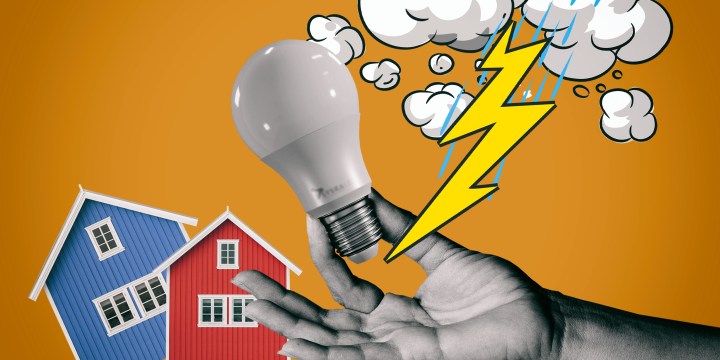HIDDEN ENERGY GOBBLERS
How to reduce your electricity usage by at least 30% without sacrifice

It may not feel like it’s our job to reduce electricity consumption in a country in dire need of more built-generation capacity – and complaining about Eskom is a favourite hobby for many South Africans. But some local engineers discovered that a lot of the daily energy we use is unnecessary, thanks to old and inefficient infrastructure and a lack of awareness about what we’re using and when. Read on for insights and energy-saving tips.
By replacing your light bulbs, scheduling your geyser usage or adjusting the charging rate of your inverter, you could cut electricity costs and put less pressure on the national grid.
And, with 88% of electricity coming from coal, it also helps climate mitigation.

Jason Samuels, co-founder of GreenX Engineering, part of start-up incubator LaunchLab at Stellenbosch University. (Photo: Julia Evans)
Replacing light bulbs could slash bills by 39%
This is what Jason Samuels, co-founder of start-up GreenX Engineering, found after helping schools in the Western Cape with their energy efficiency.
GreenX was born out of a two-year social impact project at Stellenbosch University (2019 – 2021) that was part of Samuel’s PhD in electrical engineering. It helped 25 low-income schools in Stellenbosch and Paarl to reduce their electricity consumption.
Just by installing smart metres, tracking their energy usage and replacing energy-intensive fluorescent tubes with LED (Light Emitting Diode) tubes, these 25 schools had savings of between R87,000 and R114,000, and also saved between 52 and 68 Mtoe [Million tonnes of oil equivalent] of carbon emissions.
Since then, the Western Cape Education Department made agreements with GreenX to roll out these projects in an additional 50 low-income schools in 2022 and 2023.
“When we became a business, the project expanded, which is really cool,” said Samuels. “So we’re basically just rolling out that type of service for more schools, businesses and medi-clinics.”
With more than 23,000 schools in South Africa, Samuel’s project and research discovered that by replacing inefficient lights in schools, it would reduce rolling blackouts by one stage and save R1.5-billion in energy costs.
Speaking to Daily Maverick from GreenX’s base at Stellenbosch University’s LaunchLab – a start-up incubator which its CEO Joshua Romisher calls the “silicon valley” of Africa – Samuels explained that his company gathers, measures and analyses energy data to help its clients improve their energy efficiency and environmental impact.

Energy-intensive fluorescent tubes being replaced by energy-efficient LED tubes at a public school in the Western Cape. (Photo: Jason Samuels)
LED there be light
From the data collected at the schools, Samuels co-authored a research paper in 2021, LED there be light: The impact of replacing lights at schools in South Africa. The findings were that 21% to 39% of electricity costs could be saved just by replacing fluorescent tubes with the most efficient LED lighting tubes.
MJ Booysen, the Engineering Professor at Stellenbosch University who supervised Samuel’s Phd and c0-authored the study, said LEDs use approximately 20% as much electricity as incandescent lights (these use even more energy than fluorescent lights).
“That is an 80% saving for your pocket and the environment,” said Booysen. “Moreover, you help reduce load shedding, which is hampering our economy.”
Read more: Load shedding solutions for your home
Booysen said that while purchasing quality LED lights are slightly more expensive, they could last more than five years as they have a warranty of 25,000 hours, while incandescent lights typically have a warranty for only 2,500 hours.
Booysen explained that older technologies generate a lot of excess heat in the process of generating light. “You may think back a few years, when one could not touch a light bulb after it was glowing for a while,” said Booysen. “All that heat was wasted energy. LEDs convert more of the input energy into light, which means a lot less heat.”
Samuels suggests that when buying bulbs for your household or business, look for ones that have durable tube casings (as seen in the warranty of up to seven years), high power factor of up to 0.96, and low power consumption of 18–20 watts.
Just being aware of usage makes you reduce your energy consumption
“It’s about awareness – that’s the main issue,” said Samuels. “We found that you can’t really manage your electricity usage if you’re not measuring it and aware of it.”
Samuels said that just by informing clients how much electricity they use and when, they have reduced their consumption by 11% to 14%.
As they did for Western Cape Schools, GreenX instals smart metres – a device able to measure the electricity usage of a building, and after the data is sent to a database like the iCloud, they can determine the user’s consumption throughout the day and advise them.

Energy consumption peaks throughout the day for one of GreenX Engineering’s clients. (Image: Supplied)
Just by informing users of how much electricity they use and how much it costs during different times of the day, Samuels says behavioural interventions take place without users needing to be told to make changes.
“We just said, in this gap of time you’re paying three times as much as you would in this gap of time [during a peak],” said Samuels, explaining that if users have this data, they can see if they are using energy-intensive items at peak times and making usage more expensive.
“When you ask: what can I do to change it, you move into the realm of energy efficiency.”

Jason Samuels, co-founder of GreenX Engineering, explaining to Cloetesville Primary School in Stellenbosch how their newly installed solar PV system and inverter works, on 12 August 2022. (Photo: Qclickproductions)
Making schools energy-efficient could remove one stage of rolling blackouts and save R1.5bn a year
“Our schools struggle with their financial bills, and often do not have the resources, skills, time and money to manage their electricity load,” said Booysen.
“Through Jason’s project, we were able to identify the main opportunities there are for saving energy and costs – the low-hanging fruit. And by far the biggest waste was on lights.”
The project was mainly funded by Stellenbosch University’s Social Impact division and the Western Cape Education Department.
“We found the powers that be actually install old, inefficient lights at schools, just because the initial purchasing price was less than energy-efficient lights,” said Booysen.
Samuels explained that if you looked at international literature before you’d find data for American schools, Chinese schools and Middle Eastern schools for energy usage per year for the size of the schools – but nothing for South Africa.
“And maybe that doesn’t seem important – but our schools use so much energy on a large scale,” said Samuels. With more than 23,000 schools in South Africa, Samuel’s project and research discovered that by replacing inefficient lights in schools, it would reduce rolling blackouts by one stage and save R1.5-billion in energy costs.
Cloetesville Primary School in Stellenbosch was the first school GreenX worked with. It became the first school in South Africa to receive an electrical performance certificate, with an A-rating for the electrical consumption of the system, at 17 kWh/m2.
Samuels found that if this energy efficiency was replicated across all South African schools, they’d reduce load shedding by one stage, and if all schools converted to solar power, it would reduce them by two stages.
Your inverter may be hurting the grid
To mitigate the effects of rolling blackouts, some of us have inverters and batteries which we charge when we do have power from the grid. The problem is that the rate we charge these batteries at can put further strain on our grid.
“This is taking the tool of using load shedding to stabilise the grid out of Eskom’s toolbox. Basically, we are just shifting our load out of load shedding hours,” explained Booysen.
“If 15% of households do it [charge batteries from the grid], 70% of the grid-level gains of household-load load shedding is negated.”
Booysen explained that instead we need to ensure that we set the charging rate of the batteries at slow.
“Some installers set it at 1C (eg 100A for 100Ah battery), but in fact you only need to charge at approximately 0.2C (20A for 100Ah battery) to be ready for the next bout.”
Speaking about the same concept, Samuels said that charging an inverter’s battery from the grid doesn’t need to be set to the maximum charging speed all the time as “the issue is that if it’s set to 1C (charging fastest) it’s taking too much power too quickly – and everyone’s doing that at the same time.”
Booysen said the second thing people should do is install solar power with an inverter, to offset that impact. But he added, “on the other hand, the government seriously needs to incentivise the installation of rooftop solar to complement battery backup inverters.”

GreenX Engineering is an inspiring start-up born out of a social impact project that improved energy efficiency at public schools in the Western Cape. (Photo: Julia Evans)
A few things to do with your geyser and kettle
Daniel van Schalkwyk is an electrical and electronic engineering student at Stellenbosch University, doing his PhD on the thermal energy modelling of geysers and its relationship with electrical consumption.
Read more in Daily Maverick: Check your geyser – it’s an efficient way to save energy and slash your electricity bill
Van Schalkwyk explained to Daily Maverick that many people draw a lot of energy from their hot water geysers, but there are a couple of things that can be done to save energy:
- Check the energy rating of your geyser
An energy rate of A++ is the most efficient and the least is D. However the standard for non-solar installations is B rated, so make sure your rating is not above that.
- Experiment with scheduling
“If you want to reduce energy, or if you want to at least experiment with reducing the electrical energy, then you can try switching on your geyser two to three hours before you want to shower,” said Van Schalkwyk.
Professor Booysen, whose research found that households can save between 6% and 29% of energy used by geysers, noted that is most important to switch off the geyser before starting to draw water.
So start heating two to three hours before, and turn off the geyser before you step into the shower.
- Make sure your geyser is appropriately sized for your needs and all shower at similar times
Van Schalkwyk suggests that 50 litres per person in a household should be sufficient.
“Most of the time, what’s happening is that people leave their tanks on, and because of that the entire tank gets heated up,” said Van Schalkwyk, whose PhD research is trying to determine where most of the energy sits when a geyser is in use, with the ultimate goal to aid energy management strategies with water heating load reduction.
If only one person in a household was to shower and use 50l, they’d only use a third of the water in a 150 litre tank, but they would have heated 100% of the tank.
Van Schalkwyk explained that the problem is that geysers are pressurised so they immediately fill up as water gets used, meaning the remaining water in the tank becomes cold when it’s mixed with new cold or ambient-temperature water.
It’s almost the same concept as boiling three cups worth of water in your kettle when you’re only using one cup. “People shouldn’t underestimate the influence that a kettle makes in their monthly electricity bill,” said Van Schalkwyk.
To avoid this type of wastage, it’s a good idea for most people in the household to shower at similar times and to only boil the water you need. DM





















What is meant by “durable tube casing” LED bulbs?
I think he means the old fluorescent tube, replacement LED tubes.
This is all common sense, but so useful having it set out and explained. Good article, every South African who wants to save money should read it. That’s all of us, right? Help save Eskom too from the doldrums.
All those illegal “ free” connections being disconnected would help too. As would the outstanding payments to Eskom not making their way from the Sowetan Municipality! Plus an immediate halt to corruption and skimming within Eskomitsekf!
If we all do the right thing then perhaps we have a future with Eskom until alternatives are up and running! That in itself might be why Eskom is dragging its heels in solving the problem!
Good advice. Sorry to be picky but a metre is a unit of length and a meter is a device that is used to measure.
Not the only error here, Robin!
> Samuels said that just by informing clients how much electricity they use and when, they have reduced their consumption by 11% to 14%.
That only applies to those electricity users that are on a Time of Use Tariff. An awful lot of us aren’t. But we should be.
“iCloud”? Why do we have a Crapple FanGirl using a company-specific term for a concept? The word is “Cloud”. No ‘i” necessary.
> However the standard for non-solar installations is B rated, so make sure your rating is not above that.
Drop the word “not”. Kinda changes the meaning a bit.
Otherwise, a helpful if common sense article. Thank you.
Well spotted errors.
I agree that the whole spiel about changing geyser use behaviour makes absolutely no sense for most users and is a waste of time. Only TOU users would benefit from this.
We already use a lot less electricity – thanks to blackouts.
95% of geysers in Southern Africa are installed horizontally , when they should be as the rest of the world, installed vertically. This means the hot/cold water interface area is much larger, more mixing of the different temperature water takes place. This obviously means lower temps at the hotwater outlet. Also the geyser element is situated at the bottom of the tank, so the electricity consumption is higher and it is not feasible to fit 2 elements in different positions in the tank. In the US the tanks have 2 elements(1 at each end) so the top one can be used to heat small amount of water at a time if required. All this would mean an electricity saving
I have never understood why geysers are STILL fitted horizontally in SA
Australia stopped 20 years ago Uk have never done this
Thermodynamically a vertical geyser is much more efficient in concentrating hot water at the top discharge point
Check out a “Willis”emersion heater fitting (UK equivalent of a geyser)
Cold water always stays at the bottom by principle of physic. When you take a shower/bath the hot water will fill first from the top exit and the cold water will enter the geyser from the bottom around the heater/temperature switch. A geyser can stay warm for several hours therefore you can warm your water between midnight and 4 AM and it will stay warm at your disposal. The idea of a vertical geyser is very good because the common area between the hot water and cold one is smaller.
Holy Moses!
I never knew there is a difference in geyser orientation! And I’m a designer…
Thank you very much for your comment.
As far as I know, all domestic consumers in Johannesburg have a white box which is supposed to switch off the geyser at times of high load. Does this still work?
one comment after more than 2000 fluorescent tube replacements with LED : ask them to warrant not only the 25,000 hours but also the cost of working at height 6m bulb replacement. The bulb cost is peanuts when you have to move goods, get or hire a scissor lift, etc.
That said, I was astounded at the state of the ballasts we removed in the old units! If I were an insurer I would make LED compulsory. It is probably safer storing Blitz firelighters than having ancient fluorescent tubes in the ceilings
Totally agree. The security camera of the company I worked for took a video of the ballast dripping red hot balls to start a fire in the carpet below. If the building had not had sprinklers fitted it would probably have been gutted.
I have been amazed at how effective solar domes are – for most schools, who operate during the day, there would be no lighting needed at all. Granted multistory buildings are a challenge …… but the upstairs classes and in halls it could work. Does anyone know why they are not more widely used? And why do lights get switched on in the loos? There are nearly always windows which let in plenty of light to sit or stand and do your thing.